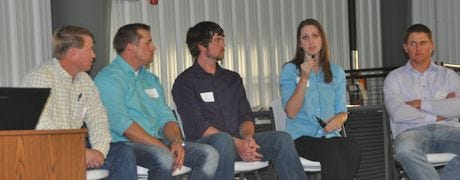
The dairy industry in Kansas is poised for growth and the state offers many of the top things that dairies seeking to move to new locales are looking for, industry members were told at a Kansas Diary Association/Kansas State University Dairy Symposium on Oct. 23 in Manhattan.
Mike Brouk, Kansas State University professor and extension specialist, told the group that Kansas is in a good place in terms of the U.S. dairy industry.
A huge increase in dairy cattle

TELLING THEIR STORY: The panel of young dairy farmers who talked about their businesses are, from left: Nathan Campbell, Ken McCarty, Justin Ohlde, Melissa Reed and Brent Buessing.
"We have seen a 60% increase in dairy cattle since 1996, milk production has more than doubled and we have seen a 48% increase in production per cow in Kansas," Brouk said. Kansas is second in the U.S. in production increases, behind only Texas and ranks 16th in the country in total milk production.
The biggest growth in the Kansas dairy industry has occurred in western Kansas where the large-scale thousands-of-cows dairies have grown over the last decade. But there has also been slow growth in the traditional Kansas dairy areas of Nemaha County and Sedgwick County, where small dairies have seen incremental increases in size.
One of the things holding back greater growth, Brouk said, is a "chicken or egg" situation over the existence of processing plants.
Kansas has seen the addition of a cheese plant in Hugoton in the last year and has cheese-making operations in the northeast part of the state at Wiebe Farms near Abilene and Alma Cheese at Alma. There are also two large milk processing plants, Hiland Dairy in Wichita and Jackson Dairy in Hutchinson. Smaller bottlers include Hildebrand Dairy near Junction City, Emrich Creamery at Onaga and Iwig Dairy at Tecumseh.~~~PAGE_BREAK_HERE~~~
In spite of these operations, more than 70% of the milk produced in Kansas is processed outside the state and Kansas milk travels hundreds of miles to processors – and consumers – in the southeast United States. This creates a huge incentive for Kansas to develop more processing ability, said Billy Brown, Kansas Department of Agriculture agribusiness development coordinator.
Significant economic value
Brown said one of the initiatives to grow the dairy industry is the value it adds to the use of scarce water resources in western Kansas.
A 3,000-cow dairy delivers $5,524 of economic value for each acre inch of water used, he said. Corn delivers $46 per acre inch and wheat about $30 per acre inch.
A panel of young dairy farmers from dairies of varying sizes talked about their business and answered audience questions during the symposium.
On the panel were Nathan Campbell, who works with his dad and brother-in-law on a diversified farm and 203-cow dairy in Sumner County; Ken McCarty who works with his parents and three brothers on a 7,000-cow dairy and evaporated milk processing plant in northwest Kansas; Justin Ohlde who works with is dad and three brothers in a 700-cow dairy; Melissa Reed from Hildebrand Dairy near Junction City, an extended family operation that includes 2,500 of cropland, a 150-cow dairy and a processing and bottling plant and Brent Buessing who works with his dad and other family members on the families 180-cow dairy and 360-acre farm in Nemaha County.
Read more about the efforts to grow the dairy industry in Kansas in the December Kansas Farmer. And be sure to follow @PJGriekspoor on Twitter for this year's Kansas Dairy tour in late November.
About the Author(s)
You May Also Like




